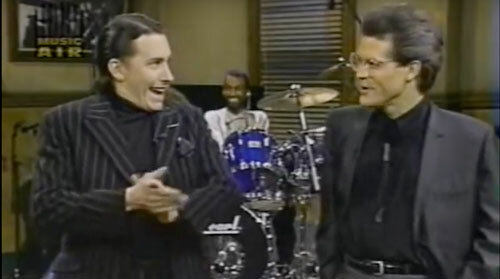
Sunday Night/Night Music hosts Jools Holland and David Sanborn.
The Sunday-night show that turned popular music into a stew
“No show on television, a medium famous for having neither memory nor latitude, has as generous a sense of musical history and democracy as ‘Night Music.’”
This great line about the show, written in a 1989 New York Times article ahead of its second season, simply states fact about what this show represented.
In a single episode in its first season, Sunday Night could have a pop star on a hot streak (Taylor Dane, still basking in her ”Tell It To My Heart” glow), a legendary soul artist (Curtis Mayfield), and a reggae musician (Shinehead).
This show could make room for a 21-year-old Harry Connick Jr. on the same night where it reunited Velvet Underground icons Lou Reed and John Cale.
And famed jazz musician Sonny Rollins and a synth-era Leonard Cohen could appear on the same episode as Was (Not Was), that funk band best known for “Walk the Dinosaur.”
And that’s just during the first season, before it got its name change to Night Music and went to first-run syndication. During season two, Eric Clapton showed up more than once. So did the Red Hot Chili Peppers, Miles Davis, and Warren Zevon. The Pixies’ American television debut came on the same night that Sun Ra and Al Green performed.
And these musicians, quite often, were brought together almost in a soup of musical talent, complete with simple formula—basically, throw them in the same room, plug everything in, turn on the cameras, and see what happens.
This was literally a music show for people who didn’t care about the pop charts, but who knew enough about music to look at the weekly lineups and go, “Holy freaking heck, how did I not know about this until now?!?”
And it had hosts who were nearly as eclectic as the artists who often performed. Sanborn, a saxophonist who was known as an instrumental icon of the smooth-jazz era, would frequently play with the very guests he would introduce as a part of the house band. And Jools Holland, a first-season host who was then a member of the band Squeeze, would soon became much better known for hosting a somewhat similar show in the U.K., Later … With Jools Holland. (Maybe like the panel show, it only makes sense across the pond.)
Of course, the show screamed ’80s. Sanborn’s big hair and the flashy suits worn by many of the male musicians gave it a somewhat establishment feel, especially at first—but then you would actually look at the musicians that they convinced to perform, and you realize that something truly special and unexpected was happening.
In a 2013 interview with Nashville Scene, Sanborn noted that the synergy was no accident: “The idea was to get musicians from different genres on the show, have them perform something individually—preferably something more obscure or unexpected rather than their latest hit—and then have a moment toward the end where everyone would kind of get together and do something collectively. That was where the whole thing started.”
Sanborn, a guy who knows his music history, borrowed inspiration from another artistically ambitious network show, the 1950s-era CBS special The Sound of Jazz. That special was just 54 minutes long and never replicated again, but the performance brought together dozens of major jazz musicians from different stylistic eras. Count Basie, Red Allen, Billie Holiday, and Thelonious Monk all shared a stage in a jam session for the ages.
In 2001, famed vintage-minded NPR broadcaster Murray Horwitz described the one-time moment as such: “It’s like having an outfield with Babe Ruth, Hank Aaron, and Willie Mays. It’s unbelievable.”
Sanborn noted that the special’s format, beyond simply bringing big names together, had a loose format that turned these legends into real people. “You could see the cameras moving around behind them as they were interacting, and it always struck me that it felt like you were getting a very intimate look into what these people were really like,” he told Nashville Scene. “They were performing, but they were more than performing.”
That sounds like a tall order to recreate on a weekly basis, and the show was by no means perfect. For one thing, the format changed frequently, something seen in the show’s ever-evolving set. The more colorful Holland was gone in season 2, with the Times noting that he “bantered relentlessly with the guests, although his efforts were often met with puzzled silence.” By the end, it was just Sanborn leading the way.
But Sanborn had a lot of help—including the help of SNL creator Lorne Michaels, the sponsorship money of Michelob, access to some deep music-industry rolodexes courtesy of SNL-affiliated producers such as John Head, and a number of game performers who found the format appealing. And that allowed the show to recreate the spirit of that one-time moment every week for two whole seasons.
This is the kind of show that would literally thrive in the era of cable television or streaming, but likely only got the level of talent it was able to on a weekly basis thanks to its big-name backing.